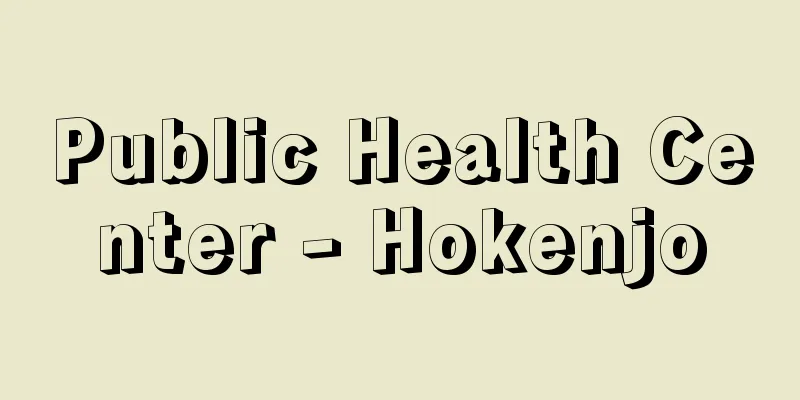Public Health Center - Hokenjo

|
Public health centers are public institutions that play a central role in local public health activities, such as disease prevention, health promotion, and environmental sanitation, and play an important role in the lives and health of local residents. Article 5 of the Community Health Law (Law No. 101 of 1947, originally called the Public Health Center Law, was amended in 1994 to its current name) stipulates that public health centers shall be established by prefectures, cities designated by government ordinance, and special wards of Tokyo. As of April 2007, there are 518 public health centers in Japan (394 run by prefectures, 101 by government ordinance-designated cities, and 23 by special wards of Tokyo). Public health centers used to be classified into urban, rural, intermediate, sparsely populated area, and branch types, but these distinctions are no longer made and the number of public health centers is actually decreasing due to the expansion of jurisdictions. [Kasuga Hitoshi] Health center activities and organizationArticle 6 of the Local Health Law stipulates that public health centers shall provide guidance and carry out the necessary activities regarding the following matters: (1) dissemination and improvement of ideas concerning community health, (2) vital statistics and other statistics related to community health, (3) nutritional improvement and food hygiene, (4) housing, water supply, sewage, waste disposal, cleaning and other environmental sanitation, (5) medical and pharmaceutical matters, (6) public health nurses, (7) improvement and promotion of public medical services, (8) maternal, infant and elderly health, (9) dental health, (10) mental health, (11) health of persons requiring long-term treatment due to illnesses with no established cure or other special illnesses, (12) prevention of AIDS, tuberculosis, venereal diseases, infectious diseases and other diseases, (13) sanitary testing and examinations, (14) other maintenance and promotion of the health of local residents. Of these, the activities of public health nurses in (6) are the origin of health centers, and have developed in their own way according to the circumstances of each country, but in every country, the basis of their activities has been public health nurse work. As regional, specialized and technical bases for local health care, public health centers are working to strengthen their functions of collecting, organizing and utilizing information, as well as investigating, researching, planning and coordinating. While closely related to school health administration, occupational health administration, and environmental conservation administration, the organizational position of public health centers in general public health administration is as follows. That is, in prefectures, the system is national (Ministry of Health, Labor and Welfare) - prefecture (health department) - public health center - city, town, and village, but in designated cities and special wards of Tokyo, the mayors and special wards are given the authority of the prefectural governor and have them carry out the above-mentioned projects through the directors of the public health centers, so the system is national (Ministry of Health, Labor and Welfare) - designated cities and special wards (health department) - public health center. Therefore, public health centers in designated cities and special wards of Tokyo are characterized by carrying out projects of general city, town, and village mayors in addition to the projects of the prefectural governor. For example, since routine vaccinations under the Vaccination Act are to be carried out by the mayors of cities, towns, and villages, prefectural public health centers only provide guidance to the cities, towns, and villages and do not carry them out, whereas public health centers in designated cities and special wards of Tokyo usually carry them out themselves. A health center typically has four departments under the director (who must be a doctor): general affairs, hygiene, health prevention, and public health promotion. However, due to recent changes in the economy and society, the size and organization of health centers have become more diverse. Health centers require teamwork among many specialists, including doctors, dentists, public health nurses, midwives, veterinarians, and nutritionists, so it is important to ensure the quality and quantity of staff in a planned manner. For this reason, training and research collaborations are conducted at the National Institute of Health, the National Institute for Environmental Studies, universities, and research institutes. Health centers also have steering councils made up of local municipalities, other administrative agencies, medical personnel, schools, businesses, and representatives of the general public, to promote public health activities that are more closely linked to the local community. [Kasuga Hitoshi] History of the Public Health CenterThe origin of health centers is said to be in 1862, when the British William Rathbone (1819-1902) divided the city of Liverpool into 18 visiting nurse districts, assigning one district public health nurse to each district to carry out maternal and child health programs, and establishing maternal and child health welfare consultation centers around these districts.In Japan, the beginnings are said to be when an urban health center was established in Kyobashi Ward, Tokyo City (now Chuo Ward, Tokyo) in 1935 (Showa 10) with assistance from the Rockefeller Foundation, and a rural health center was established in Tokorozawa Town, Saitama Prefecture (now Tokorozawa City) in 1937, and the birth of these model health centers can be said to be based on the historical inevitability of the development of public health. That is, at the end of the Meiji era, the system for dealing with quarantinable infectious diseases (which were renamed "quarantinable infectious diseases" with the promulgation of the Infectious Disease Prevention and Medical Care Act in 1998) including cholera and smallpox, which were of utmost importance throughout the era, was finally put in place. In the Taisho era, the focus of infectious diseases gradually shifted to endemic infectious diseases such as dysentery and typhoid fever, and socially significant chronic diseases such as tuberculosis, leprosy, trachoma, and parasites. Then, in the Showa era, as part of the national policy of enriching the country and strengthening the military, maternal and child health and tuberculosis countermeasures were given special attention in order to improve the physical condition and health of the people. To promote these measures, guidance that was close to the local community, such as home visits, and active health promotion measures were required, and after the spread of health consultations for tuberculosis prevention centered on the activities of public health nurses, and health consultations for pregnant women and infants, model public health centers were launched. Subsequently, in 1937, the "Health Center Law" (old law) was enacted, and the following year, in 1938, the Ministry of Health and Welfare was separated from the Ministry of Home Affairs and established. As a result, health centers also integrated various counseling centers and other facilities and took on a nationwide structure as administrative agencies, but in reality their functions did not go beyond that of a counseling center, and the reality was that local health administration during the war was still controlled by the police. This was changed after the end of the Second World War, when the government was reorganized based on the basic principles of Article 25 of the new Constitution (the people's right to life, the people's social security obligations), and the new Public Health Center Law (which became the current Local Public Health Law after amendments in 1994) was enacted in 1947 (Showa 22). This law positioned public health centers as the frontline institutions of public health administration, and made a major shift from police enforcement administration, which had continued since 1874 (Meiji 7), to scientific guidance administration. The development of a network of public health centers, with a goal of one for every 100,000 people, called for a higher level of public health administration, and public health centers are also facing a major turning point due to rapid socio-economic changes, changes in disease and population structures, and the modernization of medical care and welfare. [Kasuga Hitoshi] "Fifty Years of Public Health Centers" (1988, Japan Public Health Association) ▽ "Lecture Series on Japanese Health and Medical Care 3: Local Communities and Medical Care" edited by Shintaro Asakura, Taku Nomura, Soichiro Gigaya, Yukiyasu Nishioka, and Shuitsu Hino (1990, Labor Junposha) ▽ "How to Proceed with New Local Health Care Projects under the Local Health Care Law: The Roles of Public Health Centers and Municipalities" by Sadatake Kitagawa (1997, Japan Public Health Association) ▽ "Handbook of Health Care Facilities" edited by the Health Care Facilities Research Group (2001, Chuohoki Publishing) [References] | | | |Source: Shogakukan Encyclopedia Nipponica About Encyclopedia Nipponica Information | Legend |
|
疾病の予防、健康増進、環境衛生など、地域公衆衛生活動の中心となる公的機関であり、地域住民の生活と健康に重要な役割をもつ。「地域保健法」(昭和22年法律第101号、成立時の名称は保健所法。1994年改正により現名称となる)第5条では、各都道府県、政令で定める市および東京都特別区がこれを設置するとしている。2007年(平成19)4月現在、全国に518(都道府県立394、政令市立101、東京都特別区立23)の保健所が設置されている。なお、保健所はその性格によって都市型、農山漁村型、中間型、人口希薄地域型、支所型に分類されていたが、現在ではその区別はされておらず、保健所数はむしろ所管区域の拡大などのため減少している。 [春日 齊] 保健所活動と組織地域保健法第6条では、保健所は次に掲げる事項について指導およびこれに必要な事業を行うこととなっている。 (1)地域保健に関する思想の普及および向上、(2)人口動態統計その他地域保健にかかわる統計、(3)栄養の改善および食品衛生、(4)住宅、水道、下水道、廃棄物の処理、清掃その他の環境の衛生、(5)医事および薬事、(6)保健師、(7)公共医療事業の向上および増進、(8)母性および乳幼児ならびに老人の保健、(9)歯科保健、(10)精神保健、(11)治療方法が確立していない疾病その他の特殊の疾病により長期の療養を必要とする者の保健、(12)エイズ、結核、性病、伝染病その他の疾病の予防、(13)衛生上の試験および検査、(14)その他地域住民の健康の保持および増進。このうち、(6)の保健師活動は、保健所の起源をなすものであり、その国の事情に応じてそのあり方は独自の発展を遂げているが、いずれの国にあっても、活動の基本となったものは保健師事業であった。保健所は、地域保健の広域的・専門的・技術的拠点として、情報の収集・整理・活用・調査・研究・企画・調整機能の強化を図っている。 学校保健行政、労働衛生行政および環境保全行政に密接な関係をもちながら、一般衛生行政において、保健所の占める組織上の地位は次のとおりである。すなわち、都道府県においては、国(厚生労働省)―都道府県(衛生主管部局)―保健所―市町村の体系であるが、政令市および東京都特別区においては、その市長・特別区長に都道府県知事の有する権限を与え、保健所長を通じて前述のような事業を実施させることとし、国(厚生労働省)―政令市および特別区(衛生主管部局)―保健所という体系となっている。したがって、政令市および東京都特別区立の保健所は、都道府県知事の事業に加え、一般市町村長の事業もあわせ行うのが特徴である。たとえば、予防接種法による定期接種は市町村長が実施することとなっているため、都道府県立の保健所においては市町村の指導にとどまり、実施することはないが、政令市および東京都特別区立の保健所では、自ら実施するのが普通である。保健所の組織は、所長(医師に限られる)の下に総務課、衛生課、保健予防課、普及課の4課を置くのが一般的であるが、最近の経済社会の変動に伴い、規模と組織が多様化している。なお、保健所では医師、歯科医師、保健師、助産師、獣医師、栄養士をはじめとする多くの専門技術者によるチーム・ワークを必要とするため、職員の質と量を計画的に確保することが重要である。このため、国立保健医療科学院、国立環境研究所をはじめ、大学、研究所などにおいて養成訓練や研究協力が行われている。また、保健所には、地域の市町村や他の行政機関、医療関係者、学校、企業、一般住民代表などからなる運営協議会が置かれ、地域に、より密接した公衆衛生活動の推進が図られている。 [春日 齊] 保健所の沿革1862年、イギリスのラスボーンWilliam Rathbone(1819―1902)がリバプール市を18の訪問看護地区に分けて、それぞれ1名の地区保健師を配置して母子保健事業を行い、これを中心として母子保健福祉相談所が設営されたのが保健所の起源とされる。日本では、1935年(昭和10)ロックフェラー財団の援助を得て、東京市京橋区(現東京都中央区)に都市保健館が、37年に埼玉県所沢(ところざわ)町(現所沢市)に農村保健館が設けられたのが始まりとされているが、これらモデル保健所の誕生は公衆衛生発展の歴史的必然性に基づくものといえる。すなわち、明治時代の末には、この時代を通じて焦眉(しょうび)の急であったコレラ、痘瘡(とうそう)(天然痘)をはじめとする検疫伝染病(1998年「感染症予防・医療法」公布に伴い「検疫感染症」と呼称変更)対策の態勢がようやく整えられ、大正時代になると、伝染病もしだいに赤痢、腸チフスなどの常在伝染病や結核、ハンセン病、トラコーマ、寄生虫などの社会的慢性疾患に焦点が移っていった。やがて、昭和に入ると富国強兵の国策上から、国民の体位向上、健康の増進を図るため母子保健と結核対策がとくに大きく取り上げられることとなった。これらの推進のためには、家庭訪問などの地域社会に密着した指導や積極的な健康増進の施策が必要とされ、保健師活動を中核とする結核予防に対する健康相談、妊産婦・乳幼児に対する健康相談などの普及を経て、モデル保健所の発足となった。引き続いて、1937年「保健所法」(旧法)が制定され、翌38年には厚生省が内務省より分かれて新設された。これによって、保健所も各種相談所などを統合して行政機関としての全国的態勢をとるに至ったが、実際の機能は相談所の域を超えず、戦時下の末端衛生行政そのものは、依然として警察によって掌握されていたのが現実であった。 これが改められたのは、第二次世界大戦の終息によって、新憲法第25条の基本理念(国民の生存権、国民の社会保障的義務)に基づく行政機構の再編成が行われ、1947年(昭和22)に新たな「保健所法(94年の改正により現行の地域保健法となる)」が成立してからである。同法は、保健所を衛生行政の第一線機関として位置づけ、1874年(明治7)以来続いてきた警察の取締り行政を科学的指導行政へと大きく転換させた。そして、人口10万人に1か所を目標とした、保健所網の整備から、より高いレベルの公衆衛生行政が必要となっており、急激な社会経済の変動、疾病構造や人口構造の変化、医療および福祉の近代化に伴って、保健所にも大きな転換期が訪れている。 [春日 齊] 『『保健所五十年史』(1988・日本公衆衛生協会)』▽『朝倉新太郎・野村拓・儀我壮一郎・西岡幸泰・日野秀逸編『講座 日本の保健・医療3 地域と医療』(1990・労働旬報社)』▽『北川定謙著『地域保健法による新しい地域保健事業の進め方――保健所と市町村の役割』(1997・日本公衆衛生協会)』▽『保健衛生施設研究会編『保健衛生施設関係ハンドブック』(2001・中央法規出版)』 [参照項目] | | | |出典 小学館 日本大百科全書(ニッポニカ)日本大百科全書(ニッポニカ)について 情報 | 凡例 |
<<: Insurance policy - hokenshoken (English spelling) insurance policy
>>: Insurer - hokensha (English spelling) insurer
Recommend
Hydrogen chloride molecule - Hydrogen chloride
...Chemical bonds are what connect the atoms that...
Large scale
〘Noun〙① A unit of length in the Ritsuryo system. T...
Official - Gonkan
One of the posts placed outside the fixed number ...
Pyridoxal phosphate
...In the carboxybiotin-enzyme intermediate, the ...
Restoration Movement
…He then launched an educational movement centere...
Examiner
… [Development of critical and literary magazines...
Camel (camel) - camel (English spelling)
A large herbivorous animal with a hump on its back...
Tales of the Hōgen Era
A military tale from the early Kamakura period. It...
Kanze Yoshiyuki
A shite actor in the Kanze school of Noh. [Masuda...
Herschel, Sir John Frederick William
Born: March 7, 1792, Slough [Died] May 11, 1871. C...
Kada Arimaro
Year of death: 1751.9.23 Year of birth: 1706 A sch...
Spiraea salicifolia (English spelling)
…[Yamanaka Futoshi]. … *Some of the terminology t...
Direct cotton dyes
Dyes that can be used to dye cellulose fibers suc...
Etiquette - Gyogisahou
〘 noun 〙 Manners and etiquette. The way of behavin...
Mazurier, CF (English spelling) MazurierCF
…Born in Lyon, she learned classical dance from a...









